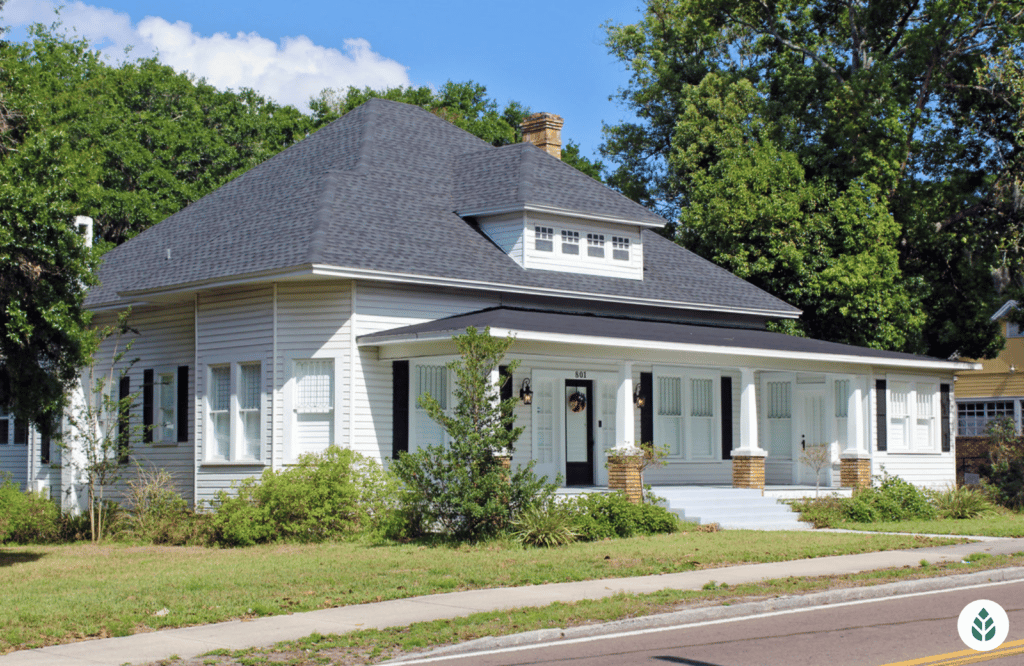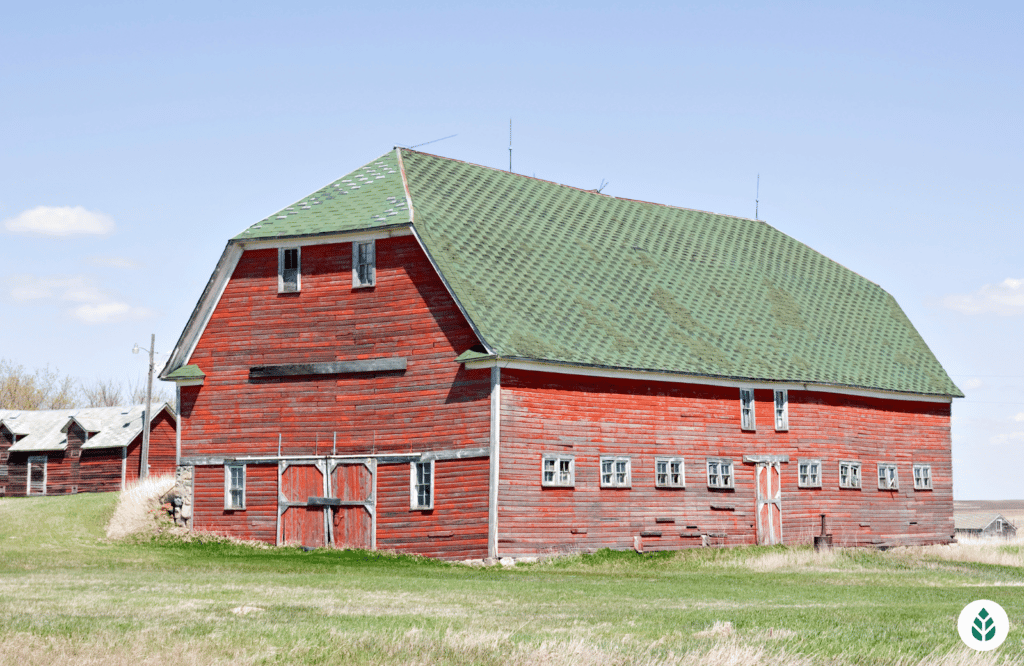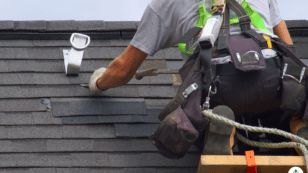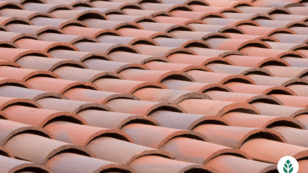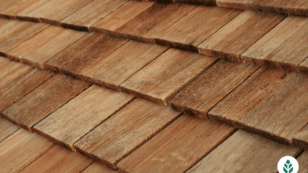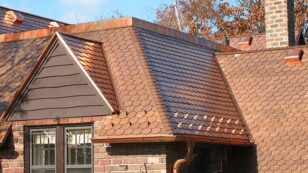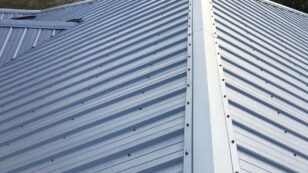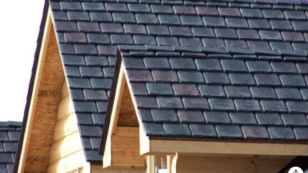
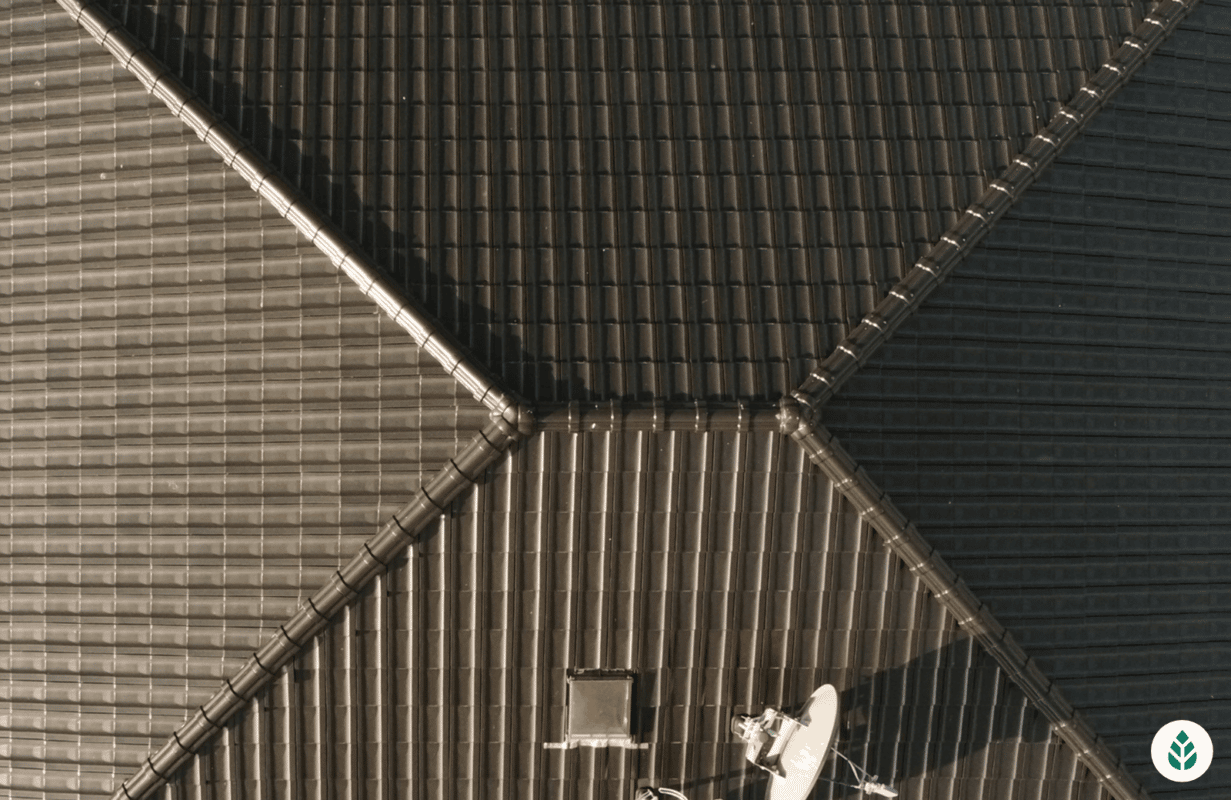
Hip Roof Cost and Homeowners Guide 2024
We’ll cover everything you should know about replacing your hip roof in this cost and homeowners guide. We’ll discuss:
- What are the pros and cons of a hip roof?
- What cost factors should I be aware of when replacing my hip roof?
- How can I best maintain my hip roof?
Each product and or company featured here has been independently selected by the writer. You can learn more about our review methodology here. If you make a purchase using the links included, we may earn commission.
What is a Hip Roof?
A hip roof is a style of roof that has four symmetrical sides that slope downwards. This simple design is very popular thanks to its durability and practicality.
A simple hip roof has four equal-length roof sections that meet at the top of the roof in a triangular shape. Hip roofs can also have a rectangular base, with two of the roof sections shaped like trapezoids and the other two shaped like triangles.
However, hip roof designs can get far more complex. Hip roofs can be incorporated into countless home styles and be combined with other roof shapes to create the desired home profile.
Cost of Replacing Your Hip Roof
The cost of replacing your hip roof will depend on what roofing materials you choose for the installation. In general, any type of roofing material can be installed on a hip roof. Here’s the average material cost per square foot for some of the most popular roofing materials:
- Asphalt shingles: $4.00–$7.50
- Aluminum: $3–$9
- Galvanized steel: $4.00–$5.30
- Clay tile: $13–$18
It’s important to remember that the location, size, slope and features of your roof will largely determine the total cost of your roof replacement project.
To get the most accurate estimate of what your new roof will cost, select one of our recommended roofing providers below to get a free, personalized quote.

Power Home

Average cost
Pros
- Positive industry reputation
- Lifetime or lengthy warranty
- 10+ years of experience
- Positive customer reviews
- Uses eco-friendly materials
- Well-trained, certified installers
- Variety of roofing styles available
Cons
- Limited variety of roofing materials
- Short or nonexistent warranty
- No financing information available
- Expensive
- Little information available on company website

Erie Home
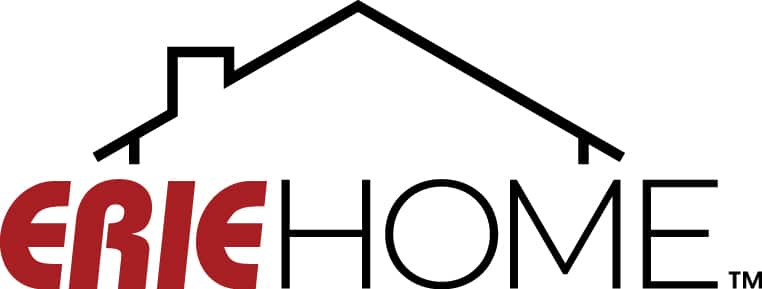
Zero Down - 18 months same as cash with minimum monthly payment
Average cost
Pros
- Lifetime or lengthy warranty
- Widespread availability
- 10+ years of experience
- Positive customer reviews
- Uses eco-friendly materials
- Financing options available
- Well-trained, certified installers
- Uses durable materials meant to last
- Variety of roofing styles available
Cons
- Limited variety of roofing materials
- Expensive

Aspen Contracting

Average cost
Pros
- Positive industry reputation
- Lifetime or lengthy warranty
- Widespread availability
- 10+ years of experience
- Positive customer reviews
- Financing options available
Cons
- Little information available on company website
Factors That Go Into Hip Roof Pricing
Hip roofs are quite common, so if you have a house with a hip roof, you can expect to pay average prices for a new roof installation. Outlined below are the factors that go into hip roof pricing.
Material Pricing for Hip Roofs
The material pricing for your hip roof installation will depend on which roofing material you choose. Hip roofs are compatible with almost any roofing type, so your roof replacement cost can vary greatly depending on which one you choose.
Basic Labor Cost and Time to Complete Hip Roof Installation
The construction costs of building a new hip roof are higher than for a standard gable roof due to the complexity of the roof style and the necessary building materials.
However, installing a new roof on an existing hip roof shape is a common project for roofers. The national average hourly rate to hire roofing contractors is $75 an hour, but this will vary depending on where you live.
Removing Your Current Roof and Dump Fees
If you are hoping to replace your existing roof, depending on how many layers of roofing you currently have you’ll need to remove and dispose of the old roof before you can install the new one. If you choose to install a metal roof, it can usually be installed directly on top of your old shingles.
Most roofing materials (even asphalt) can be recycled, so call your local recycling or solid waste management center to see if recycling facilities exist near you.
Although most roofing companies will dispose of your old roofing for you (for an additional cost), you should discuss who will be responsible for this task before the roofing project begins.
On average, it costs between $30 and $50 to drop off a truckload of old roofing shingles at your local solid waste management center. You may also have to rent a dumpster to collect the materials and trucks to transport it.
Size and Complexity of Your Roof
The larger your roof, the more you’ll pay in labor and material expenses. Additionally, If you have a steeply pitched roof, your roofer will have to use more safety equipment and take more precautions to complete your roof installation.
Roof features like a chimney, skylight windows, multiple tiers, and ventilation systems increase the complexity of your roof and can also lead to higher labor costs.
If you’d like to know how much your roofing project is going to cost, you can select one of our top roofing providers below to get a free, personalized quote.
Pros and Cons of Installing Hip Roofs
When replacing your roof, you’ll want to carefully weigh the pros and cons of each type of roofing material and style. If your home already has a hip roof, you’re in luck. Hip roofs are resilient and very popular. Here are the major pros and cons of hip roofs:
Pros of Hip Roofs
Hip roofs are so popular because they are durable, versatile and practical. The advantages of hip roofs include:
- Withstand heavy snow, rain and winds: Because a hip roof has four sloping sides that support themselves, this roof design is self-bracing. This means that hip roofs are more durable against weather damage than other roof shapes, including damage from strong winds.
- Channel precipitation away from your roof: The hipped edges of this roof shape channel rain, snow and hail away from your roof. That makes hip roofs great for climates prone to hurricanes or snow storms. Precipitation won’t gather in the valleys of your roof and cause damage.
- Great for gutters: Of course, as your roof channels away water, you’ll need a drainage system to ensure water is properly directed away from your home’s foundation. Most types of gutters are compatible with a hip roof, so installation is easy.
- Compatible with most roofing materials: Hip roofs are very versatile — you can install asphalt shingles, clay or concrete tiles, slate shingles and any kind of metal roofing on a hip roof.
Cons of Hip Roofs
Like any type of roof, hip roofs have their disadvantages as well:
- Limited living space under the roof: Because all four sides of a hip roof slope down relatively steeply, the living space under your roof can be limited. You will probably be unable to create a living area under a hip roof as you may have insufficient livable space.
- More expensive to build: If you’re building a new house, hip roofs are more expensive to construct than gable roofs. That’s because the four-sided structure has a more complex design and requires more building materials.
- Seams and design features can lead to leaks: The hipped sides of your roof have more seams, which can leave you vulnerable to roof leaks if your roof is not installed and maintained properly. Additional design features like dormers also present the same issue.
If you’re replacing your roof, we can help you get connected with the best companies for roof installations. Select one of our recommended roof installation companies below to get started with a free, personalized quote.
Variations of Hip Roofs
Although a standard hip roof has four sloped edges, there are some variations of this style:
- Gable roof: Gable roofs have two sloping sides instead of four. They range in complexity and style from simple front gable roofs to more complex cross gable roofs. Other types, like open gable roofs, can be installed on homes with hip roofs.
- Polygon hip roof: A polygon hip roof has more than four sloping sizes, creating a cone-like roof shape.
- Jerkinhead roof: A jerkinhead roof, also known as a half-hipped roof, combines the styles of a hip roof and a gable roof. One or two of the sides of a jerkinhead roof are cut or “clipped” off, while the other sides extend down to the exterior walls like a traditional hip roof.
- Dutch gable roof: A Dutch gable roof is another style that combines elements from hip and gable roofing. It’s essentially a hip roof that is topped with a gable.
- Cross hipped roof: A cross hipped roof is a more complex iteration of a hip roof, creating an L-shape at the base of the roof, rather than a rectangle or square.
Lifetime and Durability of Hip Roofs
Hip roofs are designed specifically to endure harsh weather conditions. Because they have four sloped sides (rather than just two), they are more stable than standard gable roofs. That means they’re suitable for climates that get heavy rain, snow or high winds.
How frequently you have to replace your hip roof depends on the type and quality of roofing materials you use. Hip roofs are suitable for almost any roofing material, so you have freedom to choose the best roofing materials for longevity and durability.
Asphalt shingles typically only last 10 to 35 years, whereas metal roofing can last 40 to 75 years.
Are Hip Roofs Energy Efficient?
The type of hip roof you have affects the energy efficiency of your home. For instance, if your hip roof has eaves (the edge of your roof that extends over the side of your house), the extra shade from these overhangs naturally keeps your home cooler, leading to lower energy consumption.
Like any other type of roof, the roofing material on your hip roof will have a major impact on your home’s energy efficiency. Opting for reflective materials like metal can keep your home’s temperature more regulated in both the warm and cool months. That means you’ll have lower energy bills year round.
If you’d like to speak with a professional about your roofing project, select one of our top-recommended roofing companies below to get started.
Financing Your New Hip Roof
A roof replacement isn’t cheap. Thankfully, there are plenty of manageable financing options for your new roof.
Also keep in mind that a new roof installation will increase the value of your home, allowing you to reclaim some of the money you invest in your roofing project.
Most roofing companies will work with you to find a financing option that’s best for you. Your options will typically include financing directly from the company or with a third-party lender or bank.
If you are a low- or middle-income household, you may be eligible for certain home improvement loans and grants. For instance, you may be eligible for a Title 1 loan through the Federal Housing Administration (FHA), which helps homeowners secure a home improvement loan with a low interest rate.1
Certain demographic groups, including veterans, seniors and Native Americans can receive assistance through government programs as well. Learn more at usa.gov/repairing-home.
Costs of Maintenance and Repairs for Hip Roofs
If you have a hip roof, you’re in luck. Hip roofs are resistant to heavy rain, snow and high winds. The hips of the roof allow water to flow off your roof, rather than settling into the valleys.
That being said, your hip roof may still occasionally need a leak repair or shingle replacement. On average, it costs between $200 and $500 to hire a professional roofer to fix a leak or replace damaged or missing shingles on your home.
It’s also possible to DIY a simple roof leak repair, but make sure you have the right tools and knowledge first. Never climb onto your roof without taking the proper safety precautions.
It’s also possible to take some preventative measures to protect your hip roof from weather damage. Gaps under the ridge caps of your roof can cause water to blow in and potentially cause the caps to come loose in the wind.
In that case, roofing expert Todd Miller recommends that you “put a lineal flashing up to the hips before the roofing is installed.” This can “channel any water that does enter down to the bottom of the roof, allowing it to exit there.”2
Cost of Cleaning Your Hip Roof
The cost of hiring a contractor to clean your hip roof depends on the features and slope of your roof. However, the national average cost to hire a professional to clean your roof is between $250 and $650.
Cleaning your roof annually (or as needed) is an important part of roof maintenance. Not only does it keep your roof looking new, it can remove algae and mold that damages your shingles.
If you’d like to get connected with a roofer to discuss roof maintenance or installation, select one of our top providers below to get started with a free, personalized quote.
Are Hip Roofs Worth the Cost?
Hip roofs are usually more expensive than gable roofs because they take longer to build. Hip roofs have four sloping sides instead of just two, so the construction process is more complex.
However, if you live in an area that experiences extreme weather, a hip roof is worth the cost. Hip roofs have fewer valleys than other types of roofs where rainwater, snow or hail can pool or pile up, weighing on your roof and causing damage. Hip roofs can also withstand heavy winds more easily than a gable roof.
If your home has a hip roof, it’s best to choose a durable roofing material that will last longer than standard asphalt shingles. Metal roofing materials like aluminum and steel panels are great alternatives because they are more durable and have a longer lifespan than asphalt shingles.
That being said, if you’re considering a new roof installation, you should speak with a roofing professional to discuss your options. If you’d like to get started, select one of our top-recommended providers below to get a free, no obligation quote.
FAQ: Hip Roofs
Are hip roofs a good investment?
Higher construction costs can mean that hip roofs are more expensive than gable roofs. That being said, hip roofs are a great investment because they are very resilient against harsh weather conditions.
Are hip roofs good for solar panels?
Hip roofs can be good for solar panels, but roof space may be a concern. Hip roofs can frequently have less square footage than you’d think, limiting the number of solar panels you can install on your home. It’s best to speak with a top-ranked solar company and get a home inspection before you decide if solar panels are right for you.
Do hip roofs give you more attic space?
Due to the sloped sides of the roof, hip roofs have less usable attic space than a gable roof. However, dormers on a hip roof can work around this by maximizing the space (and natural lighting) in the your attic area.

 233k
233k  41k
41k  Subscribe
Subscribe 
